5 Reasons Why I Am Glad I Switched to a Film Rangefinder for Street Photography
By Eric Kim
For nearly two years, I shot street photography entirely with a DSLR (the Canon 5D to be specific). I had always heard of people primarily using rangefinders for street work, but wasn’t quite sure why that was the case. The Canon 5D had everything I needed: a nice and bright viewfinder, sharp image quality, and high-ISO capabilities. I didn’t think I was missing anything. How little did I know.
My first experience shooting with a rangefinder came around when I inherited a Contax IIIa film rangefinder from my father. It was actually my grandfather’s, who passed away when I was 2 years old. My Dad initially got the camera from my grandfather, but didn’t use it much and simply let it stay dormant in a bag, tucked away in a closet. When he found out that I was very into photography, he suggested that I use it. After several months of shooting with my film rangefinder, I am never going to go back to shooting with a DSLR. Let me explain below.
• I get more keepers
When shooting street photography with my Canon 5D, I shot with a 16GB CF card. This meant that even when shooting in RAW, I would be able to take thousands of images without even worrying about running out of space. However, shooting with a film rangefinder is much different.
In each roll of film, I only have twenty four exposures or so—which forces me to truly think before I take my images. With my DSLR, I would simply take too many images, which would be a pain in the ass to filter through after importing my images to my computer. To compare the difference, I would say that I got 3 “keepers” after shooting 500 images with my DSLR. With my film rangefinder, I would get 3 “keepers” in every roll.
–
• I feel more in-control
Shooting with a DSLR can seem “too easy” at times. Although it is great to have autofocus and auto-exposure settings, it makes me feel that my camera controls me instead of the other way around. With my film rangefinder, I control everything. I control the aperture, the shutter speed, and the focusing all by myself.
Now why not just use “manual” mode on a DSLR? Well—it’s different. The reason why is because you will be more inclined to use auto settings with a DSLR (because you have the option). The analogy I would like to use is when people argue about getting a Kindle vs an iPad for reading books. They both read books, but the iPad can surf the web as well. So in the end, you will end up reading more books with the Kindle, as people on the iPad are typically more interested in surfing the web or watching movies instead.
–
• I enjoy the experience more
Shooting with a film rangefinder helps me “slow down.” When shooting with a digital camera, I feel much more anxious as I feel that I am obligated to take more images. With my film camera, being limited with such few shots, I feel that I can take my time and just stroll around. There is a less sense of urgency, as you know that you can’t even see your images after you process your photos.
–
• I don’t have as much attention drawn to me
As a street photographer, I love being more low-key and not always having people look at me or be suspicious of my camera. When shooting with my DSLR, I would always have people assume that I was a professional –which made me stick out like a sore thumb.
However shooting with a film rangefinder draws far less attention to myself, as it looks more “old-school” and makes me look like a hobbyist. Even after taking people’s images, people seem to notice me less or feel less threatened.
–
• I love the look of the images
Shooting with film gives you a look which cannot be emulated with any digital processing software out there. Sure you can get close, but there is something magical about the rich look of grain in your images. Digital images look far too clean and cold, and are manipulated far too easy. Film images have far more soul and character.
I am still a huge advocate with using digital for street photography for many reasons. If anything, the shortcomings of film help me appreciate digital far more. But if you happen to have an old film rangefinder handy or have a few hundred bucks to spend, I highly encourage everybody to try it out. It will be frustrating in the beginning but give it time.
I just got my Canon 5D back in the mail from being broken. I want to start shooting with it again, but I’m having too much fun with my film rangefinder. Hopefully it doesn’t collect too much dust on my shelf.
You can follow Eric on Facebook, Twitter, and Flickr.
[ad#Adsense Blog Sq Embed Image]

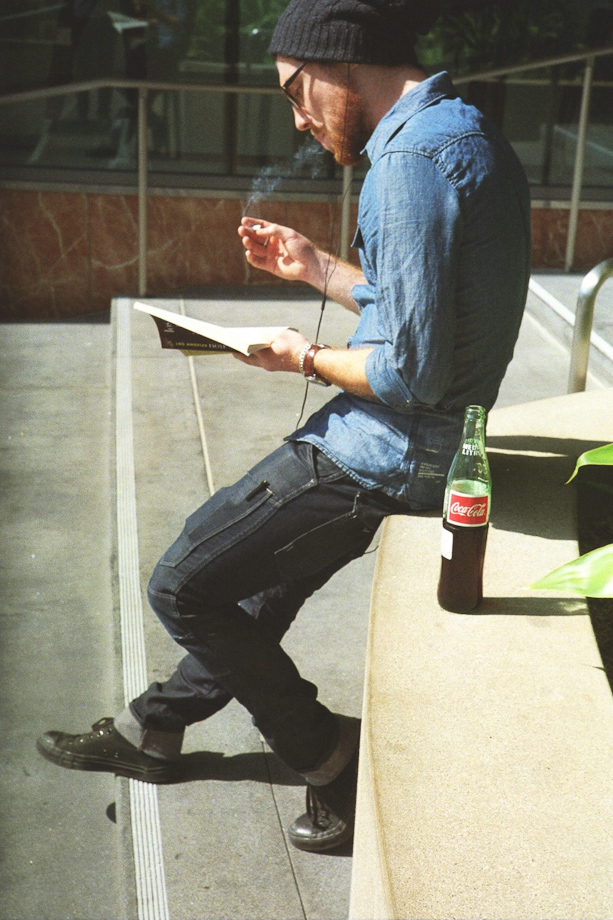
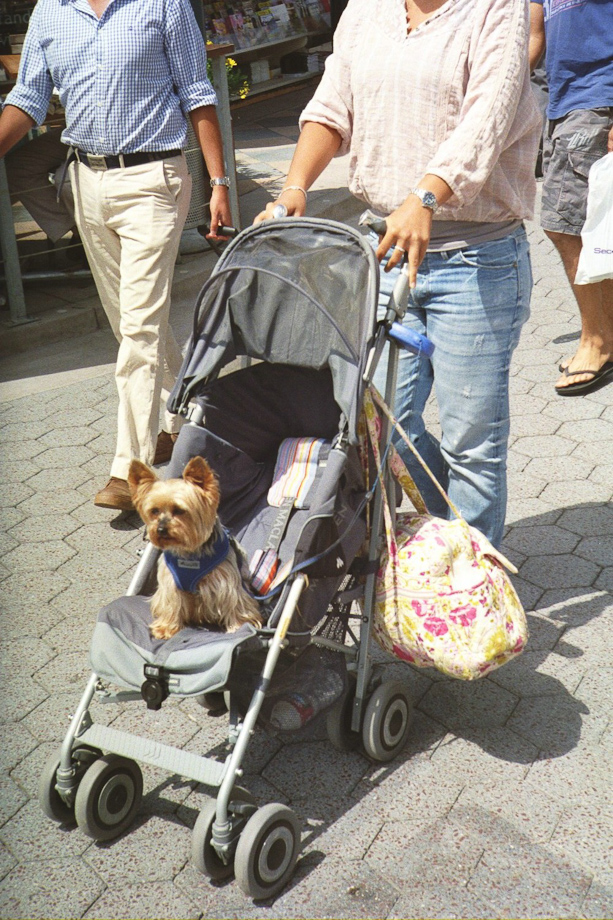
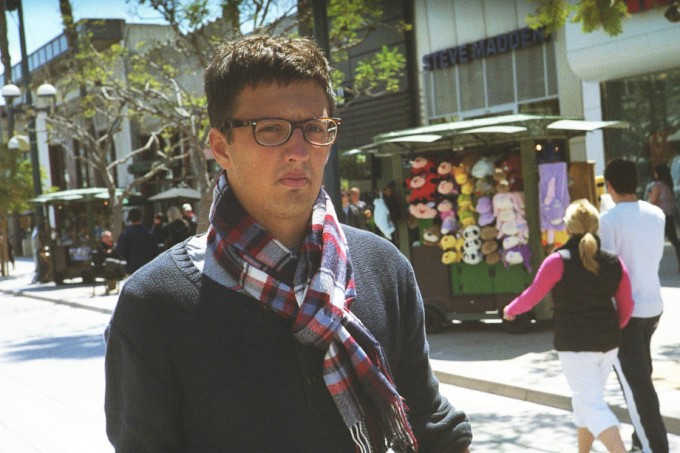
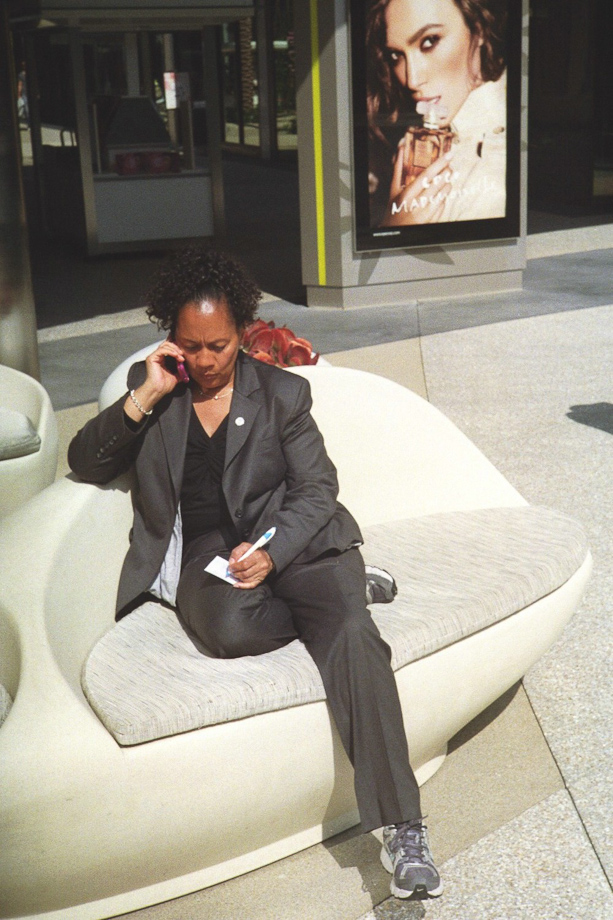
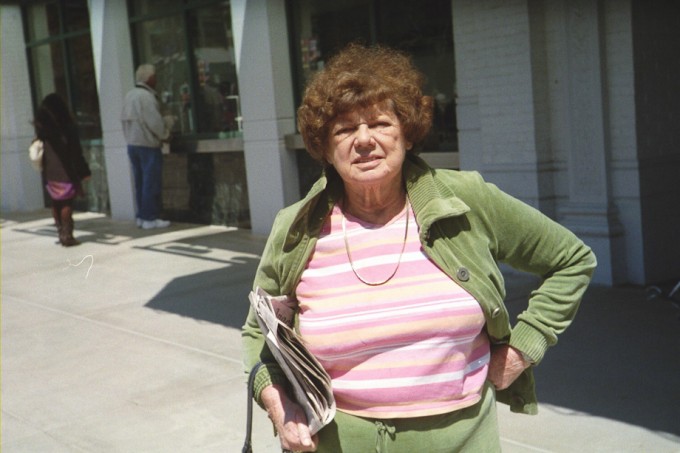

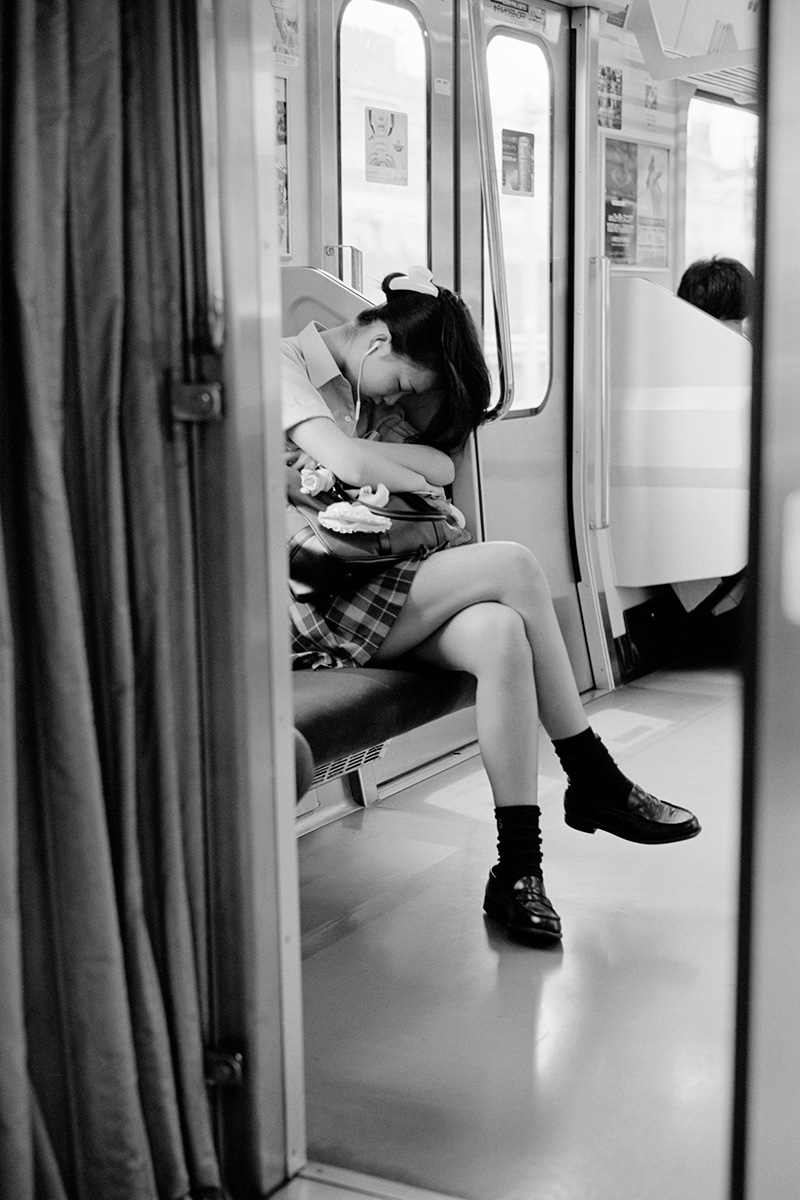
This write-up is comparing using a DSLR to shooting film with a manual camera, not necessarily a rangefinder.
I’ve been from film to digital and back and forth and back again. I have love/hate for both. In the end though, I value my film keepers more than my digital keepers. I’m not sure why, maybe it’s because the negs/slides exist in the real world as artifacts. Yeah, yeah you can print digital photos but that isn’t the original capture. If something happened and I lost, say 1000 of my negs/slides (even lousy ones) I would be crushed. If I had a hard drive crash and lost 10,000 digital photos, I’d be over it pretty fast.
BTW, you don’t need a Leica or a rangefinder for that matter to enjoy film photography. I’m having more fun and have MUCH more money in my pocket with my very reliable Nikon FA and Nikkor prime MF lens kit than I ever had with my fragile M6TTL that needed expensive rangefinder alignment nearly every year.
For me, it’s even deeper: if I hadn’t gotten delayed and winding up buying an M6, I would not have met the woman who became my wife. I started with a rangefinder in the early days of SLRs, before automatic diaphragms and instant-return mirrors. In those days I longed for a camera that would do all the grunt work for me, and with modern DSLRs with autofocus, and set on “P,” we’re just about there….and I still cannot part with my M3 and M6. DSLRs are, perhaps correctly, touted as the camera to use if you don’t want to miss a shot. Well, I’ve missed shots with both I could’ve gotten with the other. The great Andre Kertesz’s words “the best ones get away” still rings true. And I believe I do get more keepers with my film Leicas.
All great points and your reasoning is quite similar to my own reasons to go back to film after first starting off very enthusiastically on Digital. I just get better shots, better thought out, better composed and the development is fun too. I now went over to medium format cameras mostly and 35mm occasionally. I only use my DSLR for shooting 360 panos.
Street photography is so pointless. I don’t get the point of it. Let’s go around take pictures of random ppl I don’t even know! How fun!
Street photography like the ones you see above is pointless. Street photography at its best by someone like Henri Cartier Bresson is the hardest kind of photography you can do…if you can at all. Almost no one can…and the pics above prove that point.
I was thinking about this just the other day, looking at some night shots I took at the Democratic Convention in Chicago 1968: Nikon F, no in/on camera metering (“guesstimated exposure”), Tri-X pushed to 1200.
Pretty nice result though, with that unique character the method produces (and a real pain to attempt to recreate digitally today, and you never “quite” get there).
But… that was the ONLY way I could shoot that night.
No way to dial-in ISO as lighting conditions changed, for that roll I was stuck at ASA 1200 (and with all the compromises that processing method induced).
And for a for a given roll I was stuck with processing for the lowest-light shot for which I wanted to maximize the chance of success – this with *estimated* exposure under conditions where there was often a 4-5 stop difference in subject ambient across the roll (and often that much or more across the general subject withing an individual frame),,
And with no way to assess results until the film was processed.
No practical way to bracket exposure, and even had it been available, it would not have been practical given the number of shots available.
Only 36 frames available per roll – and I had maybe three or four rolls max, and changing them in the middle of a milling crowd was a chancy procedure.
And the only way to increase that was a bulk film back, which was pretty much impractical for anything but sports photography.
SLR composition under those lighting and crowd conditions was often chancy, and a RF would have been little better. There are just conditions where a screen or EVF is just superior for this sort of work, especially if like me you are 5” 8″ and are attempting to get your camera up over the heads of a crowd.
So sure, film under these conditions has its charms.
And if the fates were kind and conditions were right, you achieved some unique and highly successful results.
Perhaps 2-3 a night those conditions.
Contrast that with a modern full-frame DSLR (or even my GF1) – I would likely have gotten three or four times as many keepers, and given the large numbers of shots available and the ability to review my results in real time, I *might* have gotten the “once in a lifetime’ shot that was out there that night but hidden somewhere between the limited number of frames I could shoot, and the limited of successful choices I could make, given the equipment and media of the day.
And if you offered to time travel the *least competent* digital camera in my kit back to that night, in place of my film SLR, I’d accept without hesitation.
Now, give me conditions much closer to ideal for film, I might make a different choice.
But for that night, no contest.
It’s not the cam dude, it’s the brain……….
My best Leica-Look-Alike shots I made with my Nikon F. When there is the ‘key’ for this kind of shooting and the antennas are sensitive even a Hassy or Phase One would do the job…….good health and strong arms, of course……
except none of the pics shown are keepers
I do like the first one.
What others think about your photographs does not matter much anyway, unless you do it for a living. Even then in most cases you need to appeal to a very small crowd.
Toys for Boys – no difference if you use a classic Leica M3 oder brandnew Canon 5D.
I think we should take a moment of time to look on the pictures we make with our gear.
Yesterday it was the matter which brand you use – so we choose between Canon and Nikon.
Today we do the same between Digital and Film. Really ? Why don´t we make it out by the
pictures ? The same careless head can press the button of a M9 – or a Fuji Quicksnap.
You never need a roll of film or a Leica to slow down and make impressive work.
Capa said: If your pictures are not good enough – you are not close enough.
(Not you need a Rangefinder to make good pictures)
Eric,
I could not have said it better. I gave up on my digital Canon 5D. I also have a Leica M8.2. But, when I’m in the mood to do some photography I reach for one of my Leica M6 TTL cameras or one of my other film cameras. I take fewer photos, but when I do shoot something it’s well thought out and not a “wasted” digital shot. I think that digital photography is great. But, I also think, as you do, that looking through 500 digital shots to find a few good one, does not help a photographer improve his/her skills. You’re on right on target and one of the “smart” guys out there. I create my photographs with my Leica and great Leica glass and not with my computer and Photoshop. If I can’t do it with my Leica, then I’m not accomplishing anything anyway. Congratulations.
I learned to shoot with a Leica M4 and M6 on the streets of New York City. I loved those cameras.When I went digital I knew I was never going back. Occasionally I throw a roll of color or slide film into the M6 and have some fun. But the next day, when I pick up my D700, I don’t miss the Leica at all. Knowing how to blend in and how to get good shots with a digital SLR is as challenging to me as shooting with film and a rangefinder. More challenging, in fact, because I am forced to slow down and think not because I’m using film, but exactly because I don’t have to. I know from experience when I go out and shoot shotgun style I come back with as many keepers as I do when I go slow and take it easy, and think. Each day is different, each situation is different, and digital gives me the chance to maximize more situations. There are some awesome shots I’ve gotten because I’ve been able to shoot in a burst of 7 or 8 images with autofocus, autoexposure, and auto ISO.
And at the end of the day I don’t have to poison my lungs with the fumes from fixer. And I can work with interruptions, and I have infinitely more flexibility with processing (I was no slouch in the wet darkroom).
I guess because I grew up with film and chemicals. Using them is not a retro thing for me. It’s a stone age thing.
Jeff
You might consider getting a Canon or Epson flatbed scanner that comes with film holders. Many will give good results, which over time will bring your costs down to just film and processing. Which at Costco is about $0.50 per frame, including prints; which can also NE scanned. I have a local lab for slide film which is about the same price. But they do not process every day, so there is a wait.
PaulB
All
The truth is that any method you use to slow down your photography will force you to improve. This was true with film, and it is still true with digital.
As an exercise try the following with the camera you have.
1. Pick a lens. If the lens is a zoom, pick a focal length (use a section of bicycle inner-tube to hold the lens at this setting).
2. Put your camera on a tripod.
3. Go someplace interesting for the day.
4. Photography what ever catches your eye. But you must focus manually, set the exposure manually, and compose every shot so it is as good as you can make it. Repeat s required.
This will do three things for you. First, it will teach you to “see” at what ever focal length you selected. Second, it will help you learn composition. And third, both things will come more naturally when you need to do them fast.
PaulB
Hi Eric,
Very nice article. I miss film and I thought of going back to it a number of times. But I think buying the film, having it processed, and scanned is really expensive now. It looks like the total is getting fairly close to a dollar a frame, which is prohibitive for me. Have you fund this to be the case?
Here in Finland I pay 4.5€ for a roll of Tri-X (36exp). I develop it at home 2 films in one go. That costs 0.5€/film for chemicals and 10min of my time per film. Then I scan the film with a Nikon Coolscan 4000ED which I got second hand for 900€. Great scanning accuracy which is close to expensive drumscans. Scanning is slow so I have an old laptop to run the scanner. Add storage costs for the developed film and a great pigment printer for making those gallery-grade prints and thats it.
Saves 6.5€ per roll to develop at home and lots more to scan at home. I would not afford using film if I had every roll developed and scanned in a proper lab (not a supermarket).
Looks like you enjoy shooting in Santa Monica 🙂 Man I miss living there.
I think the lessons you’ve learned while shooting in film are directly translatable to shooting with a digital camera: there’s no reason why you can’t take the same amount of care when composing and shooting in digital. I try to do that as much as possible (I also fail miserably more often than not 😀 ).
As for sticking out like a sore thumb, yeah, shooting with a DSLR marks you out as either a tourist or pro. The problem isn’t that your camera is a digital camera, it’s that it’s a DSLR. Go with something else – anything else, from a compact camera to a Micro 4/3 or something like the X1 or X100 or M8/M9.
all pretty straightforward reasons for why street shooters prefer rangefinders. i think the lack of af lag is the biggest reason why street work is best captured with a rangefinder. the ability to zone focus for “no look”/hip shots come in a close second. just my pair of pennies. good article.
regards,
-rcl
that could be done with the ricoh GXR. It has 5m snap focus for setting or lower/higher zone. Works very very well.
Well I don’t know, I think before writing digital off (even with a Canon DSLR which is easy to do, obviously 😉 ) the images need to be 100% outstanding to suggest that fewer film images equals ‘better’. If you weren’t getting enough great images with the Canon and these are ‘better’ I’m not sure what I’m looking at. I don’t believe digital is a ‘throw away’ medium unless you treat it as one. Thousands of images with a digital camera shouldn’t be a machine gun approach to photography but a means to ‘work’ the image, to refine the elements, not a way to hope for the best.
There is nothing intrinsically better about a film image compared to a digital image if the image is good in the first place, and the number of exposures to get there is irrelevent. But not many great photographers made any great ‘street’ photographs with film without blasting away and experimenting and refining the image until ‘the’ exposure was made. And even then Winogrand or HCB or Frank would carry on just to make sure they couldn’t do even better. So they would have been like pigs in a trough with digital cameras, using the vast brain of the memory card to improve their photography, not lull themselves into a self contratulatory cul de sac about film being ‘better’ because it made them somehow selective. They never did ‘selective’, and if you had given them ten times the money to spend on film they would have used it up at an even greater rate experimenting around the scene in front of them to refine a composition.
Steve
I find that after going back to analog again, I became much more of an ‘analog shooter’ with digital as well. Digital had made me careless at first, more careless than when I used film I mean, but nowadays, I shoot so much less when I’m using digital as well. So it can influence you there, too.
Mauro,
Am looking at purchasing an m9 next month. I have an m6 which I love but M9 onwards seem to be the future….thankfully i can still keep the M6 as back-up. I had a go on M9 a few weeks ago and pretty much sold.
Looking forward to it!
Good thing about the M6 is that it still rocks. Mine is made in the late 80s and it still feels new. I hope to upgrade to M8 -> M9 some day… lucky you.
Robert,
a properly aligned M9 with calibrated lenses for me is a dream come true: digital medium format quality with P&S portability.
Forthcoming M9-P (essentially an M9 without the red logo and with anti-scratch lcd glass) could put downwards pressure on M9 price, both new and used. Keep an eye on that.
Mauro
Sounds very familiar. I went from a Canon DSLR to a Leica M8.2 to M6. Now I develop my films and use the M8 for “family parties” and M6 for creative work. M6 feels so much better to use than the M8/M9. The body is more compact and handy. The immediate response of the mechanics and the smooth *snip* of the shutter feel superior to the gadgety experience of digital. There is more pleasure in the process.
Mysticism? Can’t say there is mysticism in film shots. There is just a different, organic look. Using film does not quarantee better pictures. But having the restriction of film pushes you to actually consider every squeeze of the shutter with care.
Some pics:
http://www.flickr.com/photos/mikaelsiirila/
Great thing with Leica M is that I can carry a digital body and a film body with the same lenses. Two bodies and two lenses fit in a small bag. Both worlds always with me!
Thanks for the inspiring article!
Truly beautiful photographs Mikael – you have such a fine eye.
I agree. Great photos.
Great article. Very persuasive. Tho I do miss my FM2n I couldn’t go back to film.
So true what you are saying about taking thousands of wasted shots on DSLR. On a side note I have found since sidelining my DSLR’s and shooting exclusively on my X1, I take far less photos but get more keepers.
Keep up the good work.
Eric,
you know what ? Every time someone switches to a film rf, it looks like he is forced to write the same story: control, feel, keepers, experience, attitude. To me reality looks to me quite different: DSLR’s are poor street tools. Big, noisy, vision-restricted, useless at zone focusing. And so on. My D700 is a backup camera, in that respect.
Actually, any autofocus camera can be poor on the street. Life usually unfolds faster than phase detection.
I used to shoot MP for street, and I enjoyed a sort of “superiority” vis-à-vis the “digital mass”. Retro-snobbery, I would retrospectively define that.
When in Feb 2010 I switched to M8 and three months later to M9, I felt “liberated”: no more “film logistics” to cope with, no more dead-boring scanning, cotton gloves, tweezers, clumsy holders. No more heart attack risk every time a frame came back from the printing lab with that additional scratch. Well, I had Silver Efex in return, nothing comes entirely for free.
But what a huge payoff: shooting was 100% pure joy. And I had much more spare time on top.
Eric, I am patiently waiting for you to get hold of an M8. As you will (re)start spraying pictures like there’s no tomorrow, I bet you will get back here (or in your well written blog) with even more elaborated comments.
Best regards,
Mauro
It’s all a matter of perception, and which process you enjoy. Film has far too many disadvantages for me. I don’t buy any of the “soul and character” mysticism. Film is just chemistry, a means to a picture. It’s the picture that counts.
Totally agree. Every medium has its advantages and charms.
Also:
“I shot with a 16GB CF card. This meant that even when shooting in RAW, I would be able to take thousands of images without even worrying about running out of space.”
well, this is actually an advantage of digital format, there is nothing inherently wrong in having more options, no one is forcing you to make hasty shots with lousy composition and bad exposure, it just gives you chance to make more great photos without having to worry about running out of space/available shots.
Also knowing that you have reliable meter in the camera is great in some situations. I would totally agree about intrusiveness of DSLRs when used for street photography though (I also own Canon 5D).
This article has more to do with film than rangefinder at all…
If you want the same trouble (control everything or miss the shot) , you can get a Sigma DP2(s/x). Without using film.
Basically a Sigma Camera is everything like the old days of shooting, except its not a rangefinder and its digital.
I had a similar experience switching from a DSLR to a film rangefinder. If you really want to take the joy of photography to a whole new level…buy yourself a M3 with 50 summicron. Best camera I have ever held or used. For reference, I’ve shot Nikon (F3, N8008s, N90s, D90) and Canon (AE-1, 20D, 40D, 7D, 1D Mark III) and Leica M8.
Totally agree. I ve used several cameras from Contax, Nikon, Canon, Rollei, Leica : best one is Leica M3.
I have a M3 black 1965 a marvelous camera.
The charm of film and the pleasure of shoting
https://www.eyeem.com/u/saulaire
I could have written this myself – my thoughts are exactly the same. Great article!
Nice write up! And the “look” of film is nice. I’m always torn between wanting to get “sharp” images (which invariably look more clinical) vs. the softer but more “lifelike” look from film photos. Thanks for sharing!
Thanks for adding more doubt to my troubled life. I’ve been considering/bidding on an M6 every other day… tough choice not knowing if I would really enjoy it as much as the instant gratification that digital photography supplies. But on the other hand it would also be the only way to shoot nicely wide (21/24mm full-frame) within my budget, the style of pictures I love best. I might return to the bidding table now after your post, since I like this idea of slow deliberate photography really, with the added bonus of film’s dynamic range.
ok, just pulled the trigger on a mint M6 🙂
Congrats, you CANT go wrong with an M6.
Now we’ll be going through your great archives reading all those lens reviews 🙂
Marvelous camera in classic but prefer M3 with Leicameter MR4.
They still make 24 exposure film? 🙂 Thought it was all 36 exposure now.
All 36 exposure now? When I studied photography in art school in the 80’s, I used to buy 40 foot rolls of Tri-X and cut my own film strips to length. This was a very inexpensive way of buying film. The cut film would be fed into film cassettes using a primative feeder device. Leica made fancy film cassettes for the purpose. A cheaper way to get empty cassettes was to forage in the school’s trash where dozens of cassettes could be found… Ah, the good ‘ol days!
Wonderful article Mr Kim. 😉 🙂
Kodak and Fuji still sells 24 exposure films 🙂
Ilford sells HP5+ in 24 exposure rolls as well.
24? I could barely afford 12 in college.